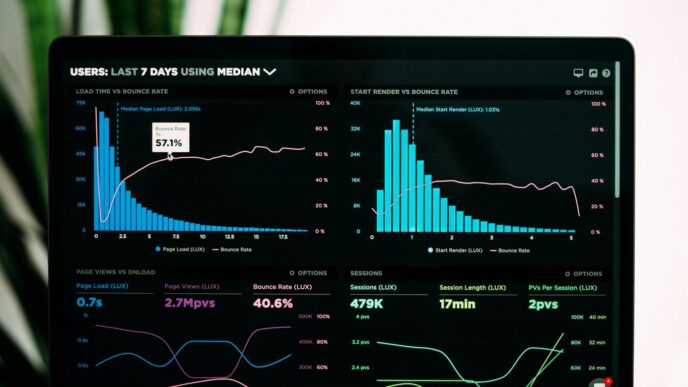Vietnam’s financial scene is really buzzing right now, especially with all the fintech stuff happening. It feels like things are changing super fast, and honestly, it’s pretty exciting to see. We’re talking about new ways to pay, manage money, and even invest, all thanks to technology. It’s not just for big companies or city folks anymore; it seems like everyone’s getting a piece of this digital pie. Let’s take a look at what’s going on and where things might be headed, especially with fintech Vietnam becoming a bigger deal.
Key Takeaways
- The fintech vietnam market is growing fast, thanks to lots of young people using smartphones and digital payments.
- New tech like AI and big data are changing how financial services work in Vietnam.
- There are good chances for investors to put money into Vietnamese fintech companies, especially in digital payments and lending.
- The government is trying to help fintech grow, but there are still some rules to figure out.
- Fintech is helping more people in Vietnam get access to banking and financial services, even those who didn’t have them before.
Vietnam’s Fintech Landscape: A Rapidly Evolving Ecosystem

Vietnam’s financial technology scene is really taking off. It feels like every week there’s something new happening, with companies constantly finding fresh ways to change how we handle money. It’s not just about payments anymore; it’s a whole ecosystem that’s growing super fast. This rapid evolution is setting the stage for significant changes in how both individuals and businesses manage their finances.
Market Growth and Projections for 2025
The numbers are pretty impressive. We’re looking at a market that was valued at around $15.67 billion in 2024. The projections show it’s expected to hit about $50.21 billion by 2030, growing at a pretty solid rate of 21.48% annually. For 2025 specifically, the growth is expected to continue its upward trend, fueled by a few key factors we’ll get into.
Key Drivers of Fintech Expansion
So, what’s making all this happen? A few things stand out.
- Young, Tech-Savvy Population: Vietnam has a lot of young people who grew up with smartphones and the internet. They’re naturally drawn to digital solutions for everything, including their money.
- High Smartphone and Internet Penetration: Most people have smartphones, and internet access is widespread. This makes it easy for fintech companies to reach customers wherever they are.
- Government Support for Digitalization: The government is pushing for a cashless society and has been introducing policies to encourage digital innovation. This creates a more favorable environment for fintech businesses.
- Growing E-commerce: As online shopping booms, so does the need for easy and secure digital payment methods. Fintech companies are stepping in to fill this demand.
The Role of Digital Payments and Mobile Wallets
This is where a lot of the action is. Digital payments and mobile wallets are huge in Vietnam. By the end of 2023, there were already over 32 million active e-wallet users. Transactions through internet and mobile banking have seen massive growth, with QR code payments really taking off – we’re talking increases of over 170% in both volume and value. It’s clear that people are comfortable using their phones to pay for things, and this trend is only going to get bigger.
Innovations Shaping Vietnam’s Financial Future
Vietnam’s financial sector is really changing fast, and a lot of that has to do with new tech. It’s not just about banks anymore; it’s about how technology is making financial services more accessible and efficient for everyone. We’re seeing a big push towards digital solutions that are changing how people manage their money and how businesses operate.
Digital Banking Maturity and Adoption Rates
Digital banking in Vietnam has come a long way. It’s not just a niche thing anymore; lots of people are using it. Banks have been pouring money into making their online and mobile platforms better, and customers are responding. Think about it: why go to a branch when you can do almost everything from your phone? This shift means banks need to be really good at offering services online, from opening accounts to applying for loans. The numbers show this trend is only going to grow, with more and more people comfortable doing their banking digitally.
AI, Big Data, and Cloud Computing in Finance
These technologies are like the engine behind all the new financial services. Artificial intelligence (AI) and big data are helping banks understand customers better, spot fraud, and even make smarter lending decisions. For example, some banks are using AI to speed up loan approvals for small businesses, which is a huge deal for entrepreneurs. Cloud computing is also a big player, allowing banks to be more flexible and store all that data securely. It’s all about making things faster, more personalized, and more secure.
Embedded Finance and Banking-as-a-Service Platforms
This is a really interesting area. Embedded finance means financial services are being built right into non-financial apps and websites. So, you might be buying something online and get offered a payment plan right there, without ever going to a bank’s website. Banking-as-a-Service (BaaS) is related, where banks essentially provide their services through APIs (application programming interfaces) to other companies. This opens up a lot of possibilities for new kinds of financial products and makes it easier for businesses to offer financial solutions to their customers. It’s all about making finance fit into our daily lives more naturally.
Investment Opportunities in Vietnamese Fintech

Vietnam’s fintech scene is really heating up, and if you’re looking to put your money somewhere with good potential, this is definitely a space to watch. It’s not just about the big banks anymore; a whole bunch of innovative companies are popping up, changing how people handle their money. The market is growing fast, and investors are taking notice.
Attractive Sectors for Capital Allocation
So, where should you be looking to invest? Several areas within Vietnamese fintech are showing a lot of promise:
- Digital Payments and Wallets: This is huge. With so many people in Vietnam using smartphones and preferring digital transactions, companies making payments easier and more secure are in a prime spot. Think about apps that let you pay for anything with your phone or services that help businesses accept digital payments without a hassle.
- Digital Lending and Credit: A lot of people in Vietnam, especially small businesses and individuals in rural areas, don’t have easy access to traditional bank loans. Fintech startups are stepping in to fill this gap with faster, more accessible loan options. This is a big area for growth, especially for financial inclusion.
- Insurtech: Insurance is another sector ripe for disruption. Companies are using technology to make buying and managing insurance simpler and more affordable. This could mean anything from micro-insurance for low-income individuals to more streamlined online claims processes.
- Wealth Management and Investment Platforms: As people earn more and become more comfortable with digital tools, they’re looking for ways to grow their savings. Platforms that offer easy-to-use investment tools, even for small amounts, are gaining traction.
Venture Capital and Startup Funding Trends
We’re seeing a definite increase in venture capital flowing into Vietnamese fintech startups. Investors are drawn to the country’s young, tech-savvy population and the government’s support for digital transformation. It feels like there’s a new funding round announced almost every other week.
Here’s a quick look at what’s happening:
- Increased Deal Sizes: While there are still many early-stage investments, we’re starting to see larger funding rounds for more established fintech companies looking to scale up.
- Focus on Scalability: Investors are keen on startups that have a clear plan to grow quickly and reach a large customer base, both within Vietnam and potentially across Southeast Asia.
- Strategic Partnerships: Sometimes, instead of just cash, funding comes with strategic partnerships. This could be with established banks looking to modernize or with larger tech companies wanting to expand their financial services.
Long-Term Growth Potential for Investors
Looking ahead, the outlook for Vietnamese fintech is pretty bright. The country has a massive young population that’s already comfortable with digital technology. Plus, the government is actively pushing for a cashless economy and digitalizing financial services. This creates a really fertile ground for fintech companies to not only survive but thrive.
Consider these points:
- Expanding Middle Class: As Vietnam’s economy grows, so does its middle class, meaning more people have disposable income and are looking for sophisticated financial services.
- Digital Infrastructure: The ongoing improvements in internet access and mobile penetration mean that more people can easily connect to and use fintech services.
- Untapped Markets: There are still significant portions of the population that are underbanked or unbanked. Fintech solutions are uniquely positioned to reach these groups, offering them access to financial services for the first time.
Basically, if you’re an investor looking for growth, Vietnam’s fintech sector offers a compelling mix of a dynamic market, innovative companies, and a supportive environment. It’s definitely worth keeping an eye on.
Regulatory Environment and Fintech Integration
Vietnam’s financial sector is really starting to get its act together when it comes to new tech. The government seems to be realizing that to keep up, they need to make some rules that actually help things move forward, not just get in the way. It’s a bit of a balancing act, trying to encourage all this new innovation while still keeping things safe and sound for everyone.
Government Initiatives and Policy Support
The Vietnamese government has been putting some effort into creating a better environment for fintech. They’ve put out policies aimed at making digital payments easier and have even started looking at how to support things like digital banking. It’s not always a straight line, but there are definitely moves being made. For instance, Resolution No. 222/2025/QH15 is a big deal, setting up a legal framework for how Vietnam will connect with the wider financial world. This should open up new doors for financial activities and international involvement.
Navigating Regulatory Complexities
Okay, so while there are initiatives, it’s not exactly a walk in the park. Some areas, like peer-to-peer lending or even crypto, are still a bit of a grey zone. Companies are trying to figure out the rules as they go, which can be tough when you’re trying to build something new and get people to invest. It means businesses have to be pretty careful and sometimes wait for clearer guidelines before they can really go all-in. The lack of a fully fleshed-out legal structure can make it hard for companies to feel secure about their long-term plans.
The Impact of Regulatory Sandboxes
This is where things get interesting. Vietnam has introduced a Fintech Regulatory Sandbox, which is basically a safe space for companies to test out new ideas. It’s a smart move because it lets them try out things like new credit scoring methods or open API systems under the watchful eye of the State Bank of Vietnam (SBV). This way, the SBV can see how these innovations work in the real world before they become widespread. It’s a way to encourage innovation without taking on too much risk all at once. The sandbox is set to officially kick off on July 1, 2025, and it’s designed to cover a range of eligible innovations from banks and fintech firms alike. This controlled testing environment is key for developing better digital financial products and allows regulators to adjust policies based on actual results. It’s a pretty big step towards a more modern financial system.
Financial Inclusion and Underbanked Populations
It’s pretty amazing how much technology is helping people who didn’t have access to banking before. In Vietnam, a lot of folks are still outside the traditional financial system, especially in rural areas. But fintech is really changing that picture.
Fintech’s Role in Reaching Underserved Communities
Think about it – many people in remote areas don’t have a bank branch nearby. Getting to one can be a whole day’s trip. Fintech platforms, though, can reach them right on their phones. This means they can start saving, get small loans, or even send money without needing to travel. This is a huge step towards making financial services available to everyone, not just those living in big cities. It’s about giving more people a chance to improve their lives and businesses.
Accessible Digital Lending and Mobile Banking Solutions
One of the biggest wins is digital lending. Instead of needing a long credit history or collateral, some fintechs use alternative data to assess loan applications. This could be anything from mobile phone usage to utility payments. It opens doors for small business owners and individuals who wouldn’t qualify for traditional bank loans. Mobile banking apps are also making it super simple to manage money, pay bills, and track spending, all from a smartphone. It’s not complicated, and it’s available 24/7.
Bridging the Gap with Digital Financial Services
So, how are they actually doing this? It’s a mix of things:
- Mobile Wallets: These are everywhere now. People can store money, make payments, and even receive funds easily.
- Micro-lending Platforms: These focus on small loans, often for farmers or small vendors, with quicker approval processes.
- Digital Savings Accounts: Simple accounts that don’t require a large initial deposit or frequent branch visits.
- Financial Literacy Tools: Some apps include basic education on managing money, budgeting, and understanding financial products.
It’s a big shift, and it’s making a real difference in people’s everyday lives. The goal is to make sure no one is left behind when it comes to financial services.
Key Players and Competitive Dynamics
The financial scene in Vietnam is getting pretty crowded, and it’s not just the old banks anymore. We’re seeing a whole mix of players duking it out, from the big state-owned banks to nimble fintech startups and even some tech giants dipping their toes in. This competition is actually a good thing for us consumers, pushing everyone to get better and offer more.
Leading Fintech Companies and Their Offerings
When we talk about fintech in Vietnam, a few names really stand out. These companies are shaking things up by focusing on specific needs that traditional banks might overlook. Think about digital payments, lending for small businesses, or even investment platforms that are super easy to use. Many of these startups are attracting significant attention from venture capitalists looking for the next big thing. For instance, some are really good at making it simple for people to send money or pay bills right from their phones. Others are focusing on giving small businesses quick access to loans, which is a huge deal for the local economy. You can explore leading FinTech startups in Vietnam, including their funding rounds, major investors, company achievements, and current development phases here.
Collaboration Between Banks and Fintechs
It’s not all about banks versus fintechs, though. We’re actually seeing a lot of banks teaming up with these newer companies. Banks have the established customer base and trust, while fintechs bring the fresh tech and innovative ideas. It’s a win-win, really. Banks can offer better digital services without having to build everything from scratch, and fintechs get access to a wider audience. This partnership approach is helping to speed up the digital transformation of the entire financial sector.
Emerging Trends in Product Differentiation
So, how are these companies trying to stand out? Well, it’s all about making things easier and more personalized for customers. We’re seeing a big push towards:
- AI-powered tools: Think personalized financial advice or automated loan applications.
- User-friendly interfaces: Apps that are so simple, anyone can use them, regardless of tech skill.
- Niche services: Focusing on specific groups, like freelancers or young entrepreneurs, with tailored products.
- Open Banking: Allowing different financial apps to talk to each other, giving customers a more connected experience.
Here’s a quick look at how some banks are innovating:
| Bank | Key Innovation | Strategic Impact |
|---|---|---|
| Techcombank | “Auto-Earning” interest account | Boosts idle money yield and customer stickiness |
| MBBank | “Biz MBBank” platform (AI, Big Data, DocAI) | Automates SME/Corporate lending approval |
| ACB | Data Lake, Biometric Authentication, Open API | Enhances data-driven decisions and customer onboarding |
| VPBank | Digital bank “Cake” | Expands reach to tech-savvy youth and micro-entrepreneurs |
Basically, the companies that are doing well are the ones that are really listening to what customers want and using technology to deliver it in a smart, efficient way. It’s a dynamic space, and it’s only going to get more interesting.
Looking Ahead: Vietnam’s Fintech Future
So, what does all this mean for Vietnam’s financial scene in 2025 and beyond? It’s pretty clear that fintech isn’t just a trend here; it’s become a major part of how things work. With a young population that’s all about digital stuff and a government that’s pushing for more cashless transactions, the opportunities are huge. We’re seeing a lot of smart companies popping up, making financial services easier for everyone, from big businesses to folks who might not have had access before. For anyone looking to invest or start a business in this area, Vietnam is definitely a place to watch. It feels like the country is really stepping up its game in the financial world, and it’s going to be interesting to see what comes next.
Frequently Asked Questions
What is fintech and why is it growing so fast in Vietnam?
Fintech is short for financial technology. It’s about using new technology, like apps on your phone, to make banking and money stuff easier and faster. In Vietnam, lots of young people have smartphones and like using new tech. The government also wants more people to use digital payments instead of cash. This makes it a great time for fintech companies to grow!
What are the most popular fintech services in Vietnam?
Digital payments and mobile wallets are super popular. Think of apps where you can pay for things with your phone or send money to friends easily. Lots of people in Vietnam are using these because they’re convenient. Other popular services include ways to get loans online and ways to invest money.
Are there good chances to invest in Vietnamese fintech companies?
Yes, many people think so! Because fintech is growing so quickly, investors are looking for promising companies to put their money into. Areas like digital payments, online lending, and new tech like AI in finance are seen as good places to invest for the future.
Does the Vietnamese government support fintech?
The government is trying to help fintech grow. They have rules and programs, like ‘regulatory sandboxes,’ which are like safe testing grounds for new fintech ideas. They want to make sure new technologies are used safely while still encouraging innovation.
How does fintech help people who don’t have bank accounts?
Fintech is really important for helping people who haven’t had easy access to banks before. Mobile apps and online services make it possible for people in rural areas or those with less money to get loans, pay bills, and manage their money without needing a traditional bank branch.
Who are the main fintech companies in Vietnam?
There are many companies making waves! Some are focused on digital payments, others on lending, and some are even helping banks offer new digital services. It’s a competitive market, with both new startups and established banks working with fintech to offer better services to customers.














